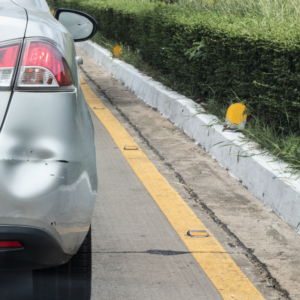As we have discussed before, Paintless Dent Repair (PDR) is a versatile technique that can work wonders in certain situations. However, it is not always a viable solution.
In this article, we will explain how PDR works and when it’s the best choice for your car.
The Paintless Dent Repair Process
The PDR process is deceptively simple but requires a skilled touch. Specialized dent removal tools are utilized to manipulate the dent either from the underside of the vehicle or by employing a glue-pull method from the exterior.
However, it’s crucial to emphasize that for successful PDR, professional expertise is essential. This is because, in some cases, trims and panels must be carefully removed and reattached to gain full access to the dent.
It’s important to note that not all dents can be effectively repaired with PDR. Our experienced team at Hammer’s Autoworks will assess your specific situation and inform you if PDR is a viable option.

Determining the Suitability of PDR
Assess the Damage
The initial step in deciding whether PDR is suitable for your vehicle involves having our auto body shop inspect the dent.
During this assessment, we consider factors such as the dent’s location, size, and any potential paint damage. Additionally, we determine how to access the dent, which is essential for successful PDR.
Once we confirm that PDR is a feasible solution, we prepare the surrounding area and commence the repair process.
Access the Dent
To access the dent with our PDR equipment, certain components of the vehicle must be temporarily removed. This includes panels, lights, and even interior panels, which are carefully taken apart to reach the underside of the dent.
This step ensures that our technicians have unobstructed access to the affected area.
Take a Closer Look
Every dent has two sides, so once we are positioned correctly, we thoroughly examine the point of impact. This close inspection enables us to determine the precise placement of our equipment for optimal results.
Apply Pressure
With our equipment in the right place, we delicately work to restore the dent to its original state. Once the repair is complete, we meticulously reassemble the components that were temporarily removed.

When PDR Isn’t the Best Choice
When faced with complex structural damage, severe paint damage, or other conditions that don’t align with the strengths of PDR, traditional repair methods may be more appropriate.
Hammer’s Autoworks can assess your specific situation and recommend the best approach to restore your vehicle’s aesthetics and structural integrity effectively.
Here are some scenarios where PDR may not be the best choice:
- Complex Structural Damage: PDR is primarily designed for minor dents, dings, and creases. In cases of severe structural damage or creases that have caused the metal to stretch, PDR may not be sufficient to fully restore your vehicle’s integrity.
- Paint Damage: If the dent has caused significant paint damage, such as chipping, flaking, or deep scratches, PDR may not be the best option. The technique does not involve repainting, so it won’t address paint-related issues. In such cases, traditional dent repair methods that include painting may be necessary.
- Inaccessible Dents: Dents located in areas that are challenging to reach with PDR tools, such as inside wheel wells or beneath the vehicle, may not be suitable for this technique. Access limitations can hinder the effectiveness of PDR.
- Dents with Sharp Edges: PDR works best on dents with smooth, rounded edges. Sharp dents or creases with jagged edges are less likely to respond well to this method.
- Hail Damage Over a Large Area: While PDR can effectively repair individual hail dents, extensive hail damage covering a significant portion of the vehicle may be better addressed using traditional repair methods to ensure a comprehensive and uniform restoration.
- Age and Condition of the Vehicle: If your vehicle is older or has worn or brittle paint, it may be more susceptible to paint damage during the PDR process. You should always consider the age and condition of your car when deciding on the appropriate repair method.
- Insurance Considerations: Depending on your insurance coverage and policy terms, PDR may not be covered for certain types of damage. Be sure to consult with your insurance provider to determine the extent of your coverage for PDR.
If you’ve been putting off repairing a bothersome dent on your vehicle, it’s time to talk to Hammer’s Autoworks. Our skilled technicians will assess your dent and guide you on the most appropriate repair method, ensuring your vehicle looks as good as new.
Whether PDR is appropriate for your situation or not, you can guarantee Hammer’s Autoworks will fix it right.

